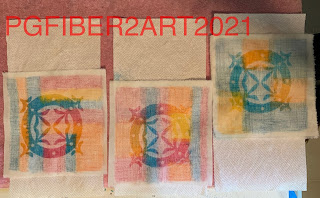Four years ago, Sue went to Craft Napa with 2 friends for 3 days of fiber art classes. What a fun time! Things haven't worked out to return to this California retreat, but this year because of the pandemic, it moved online like so many other events. Being virtual, anyone could participate from the comfort of home. So Sue signed up for one class. There were others she was interested in, but as sometimes happens, several were on the same day so choices had to be made. The class she took was called Surprise Printing taught by Margarita Korioth. The technique involved using Caran d'Ache water soluble wax pastel crayons with transparent extender and silk screens to created printed blocks. The "surprise" is seeing what your blocks look like after washing off the excess crayon.
To create blocks, we first colored the cotton squares with the wax pastel crayons. Then we used the silk screen to overprint with the transparent extender. These were then set aside to dry. We also made a repeat pattern with the other screen on a rectangular piece of cotton. The third component created was a wide strip that could be cut into narrower strips for sashing and/or binding. This piece was done by separating it into segments with painter's tape and coloring in between. The transparent extender was brushed over top. All were allowed to dry before heat setting and then soaking in water (about 10 minutes) to remove the excess crayon. The extra color doesn't come out completely, but enough to fade into the background and allow the printed design to stand out.










